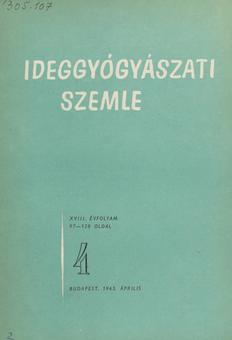The eLitMed.hu medical portal uses computer cookies for convenient operation. Detailed information can be found in the Cookie-policy.
Clinical Neuroscience - 1965;18(04)
Content
[After twenty years]
[The experience of the past 20 years: in the face of our shortcomings and failures to we can continue our work in the hope of success.]
[Investigation of neuromuscular synapses in muscle diseases]
[From the muscle biopsy material of our clinic, the subneural apparatus of the myoneural junction was examined in 32 cases by the Koelle acetylthiocholine method, and the neural part by the Bielschowsky-Gross-Schultze method modified by Coers. The amount of material studied by these tests is small in relation to the number of biopsies performed in our clinic. However, also according to our previous results, we have seen that in ALS the subneural apparatus is relatively uniformly smaller, with variable size in the initial stage of dystrophia musculorum progressiva, with more large, hypertrophic forms, while in the later stage we find smaller, more irregular forms. Intramuscular nerve fibres showed irregular course, thinning in ALS, and irregular, degenerative axonal swellings in dystrophies. We do not want to draw any far-reaching conclusions from the material we have examined so far, but based on the literature and our initial experience, we see that further and more extensive studies in this direction are absolutely necessary to better understand the pathology of skeletal muscle. ]
[Effect of local brain hypothermia on ECoG and experimental epileptiform activation]
[Monopolar corticographic drainage was performed in dogs with chloralose narcosis after extensive craniotomy mk.o. Cooling of the brain surface was performed with circumscribed cold fluid. Brain temperature was measured with a copper-constantan thermoelectric thermometer at a depth of 2-3 mm. The experiments yielded the following results : 1. Electrocorticographic recordings could not demonstrate that certain phases of brain hypothermia are associated with an increased excitability state; 2. A different relationship between the change in locally generated strychnine spike activation and the change in baseline activity during cooling and spontaneous warming was observed; 3. The brain electrical activity activated by Tetracor during cooling was similar to that in unactivated cases. 4. local brain cooling on either side does not significantly affect either the basal opposite-side activity or the opposite-side strychnine-spike activity activated with Tetracor or generated locally, but eliminates the opposite-side mirror focus. Therefore, local brain cooling can be used as a probe to determine the primary or secondary nature of the counter-side spike activity.]
[Additions to the study of the schizophrenomimetic effects of phencyclidine. Based on a self-experiment with Elysion]
[The author describes in detail his sensory and psychic hallucinogenic experiences of a schizophrenic-like symptom cluster lasting several hours, induced by intravenous phencyclidine (Elysion). ]
[lzonicotinic acid hydrazide poisoning effects on the central nervous system]
[In a patient taking 250 tbl of INH "as a replacement", after a single epileptic seizure, somnolons for 3 days, gradually improving bradypsychia for 1 month, other symptoms typical of epileptic character changes, and a slowing of brain electrical activity, epileptiform potentials, which settled after two months, were observed. This process was monitored by EEG, time-lapse studies, Rorschach tests. Our observations and the literature review suggest that epileptic and psychic changes are related to a disturbance of pyridoxine-GABA metabolism. We emphasize the difficulty of recognizing INH-intoxication and its prevention. ]
[The use of the modified permanganate response in the early detection of neuronal constriction in early CSF diagnosis]
[The described permanganate methodology seems to be a significantly more informative method than the usual CSF test in the diagnosis of neurovascular constrictions containing low mg% CSF. In the authors' opinion, it is not the protein amount or the accumulation of certain protein fractions that is responsible for this behaviour of the reaction, but the biochemical changes that occur as a result of the space-constricting process, which the authors aim to clarify further. ]
1.
Clinical Neuroscience
[Headache registry in Szeged: Experiences regarding to migraine patients]2.
Clinical Neuroscience
[The new target population of stroke awareness campaign: Kindergarten students ]3.
Clinical Neuroscience
Is there any difference in mortality rates of atrial fibrillation detected before or after ischemic stroke?4.
Clinical Neuroscience
Factors influencing the level of stigma in Parkinson’s disease in western Turkey5.
Clinical Neuroscience
[The effects of demographic and clinical factors on the severity of poststroke aphasia]1.
2.
3.
4.
5.



